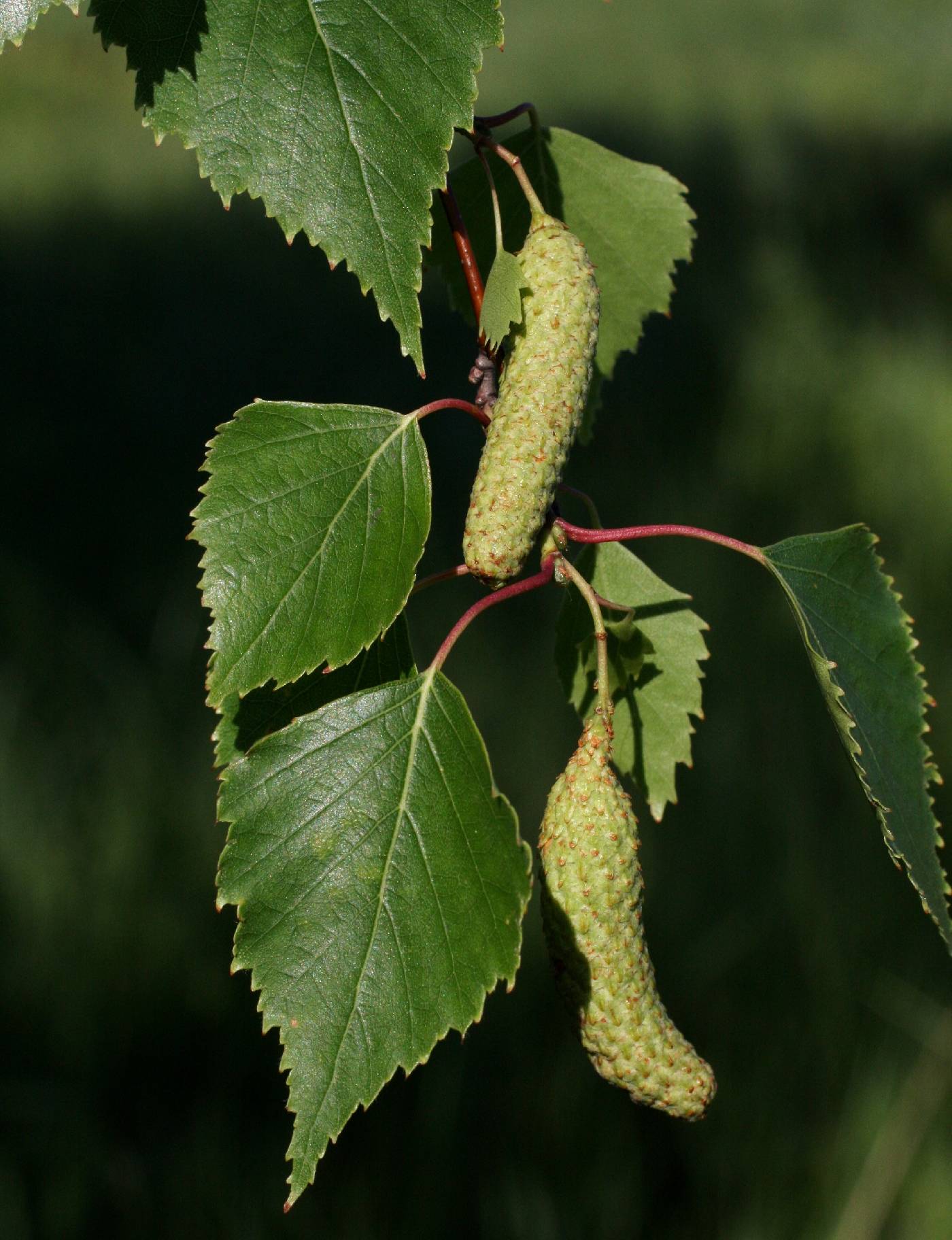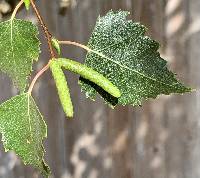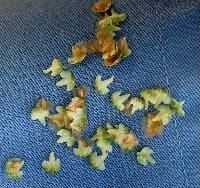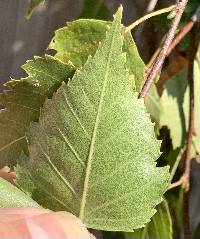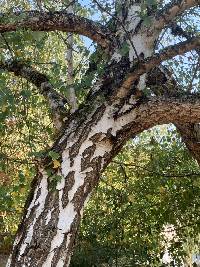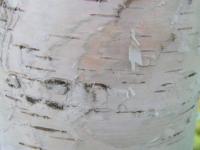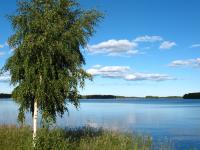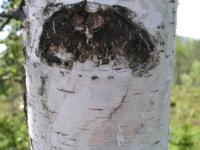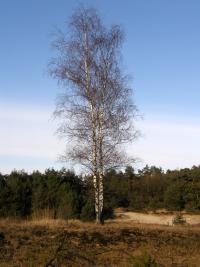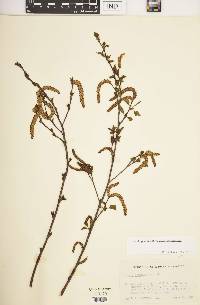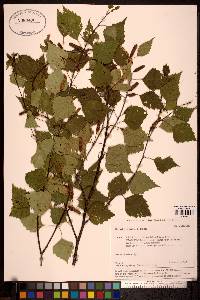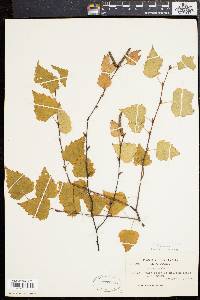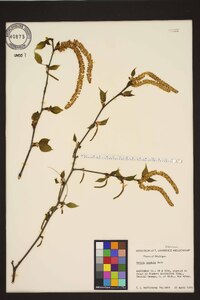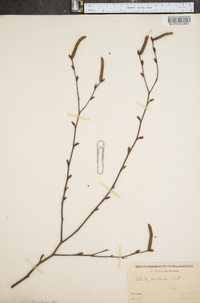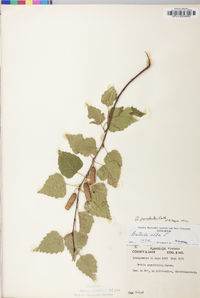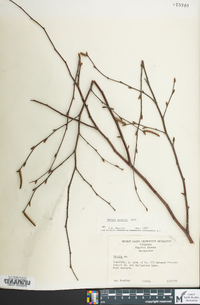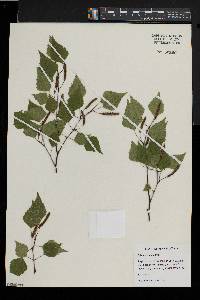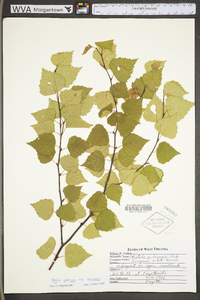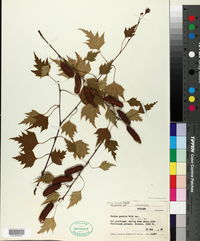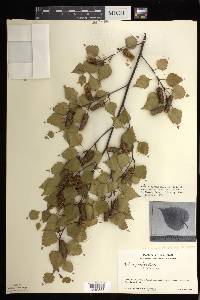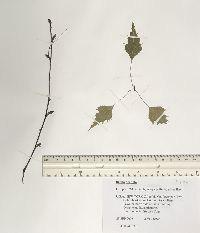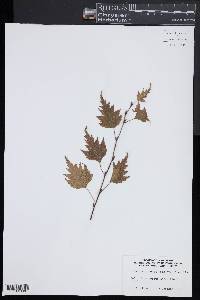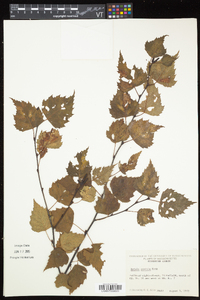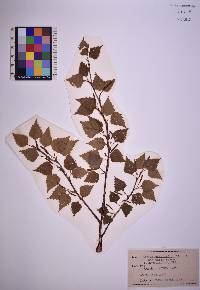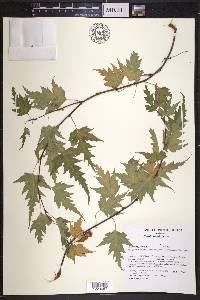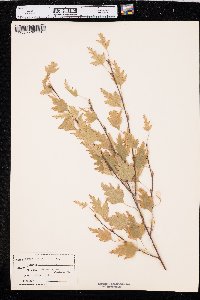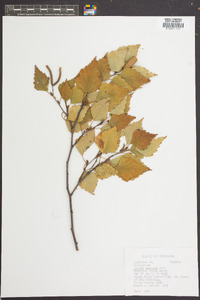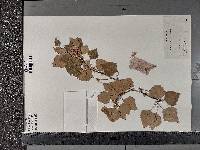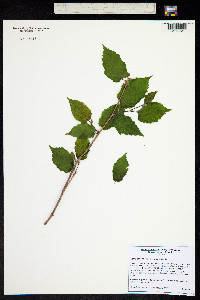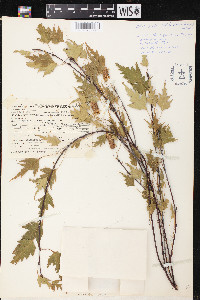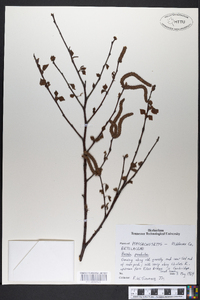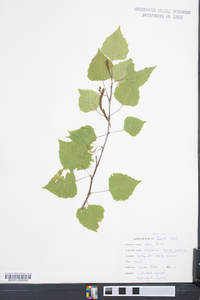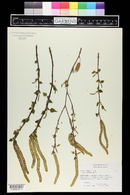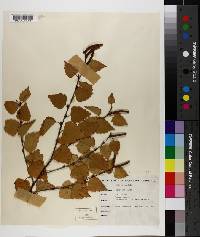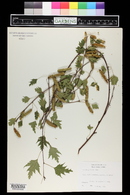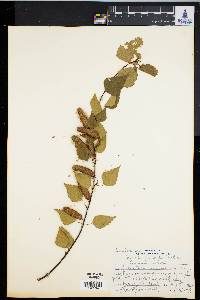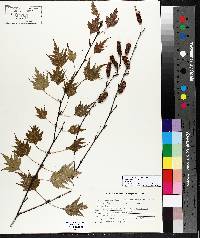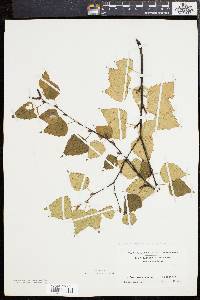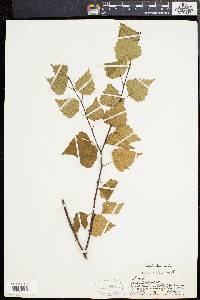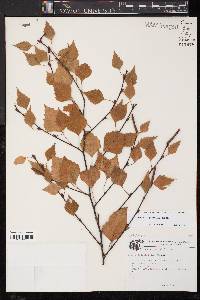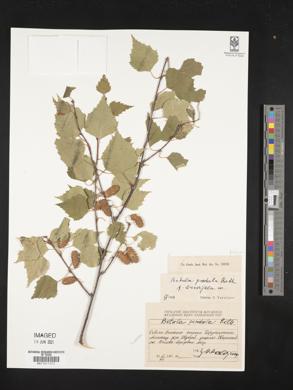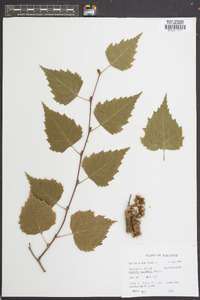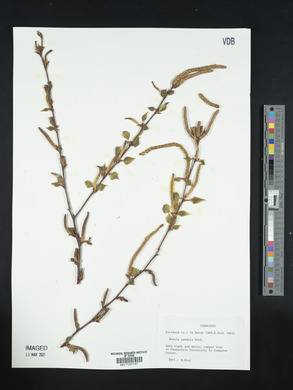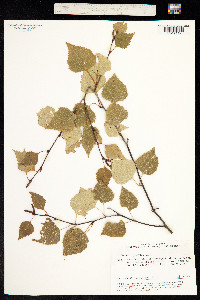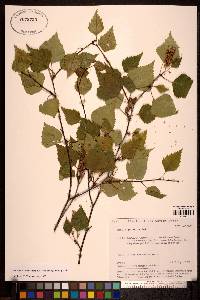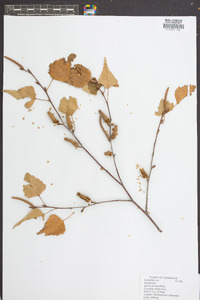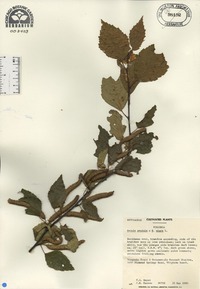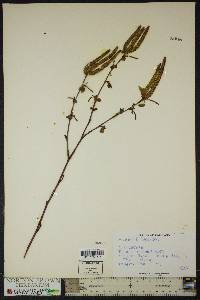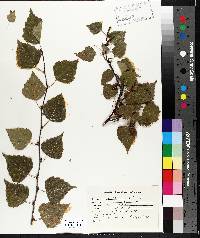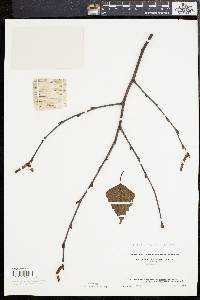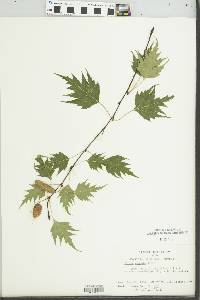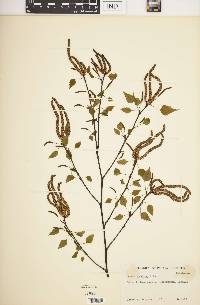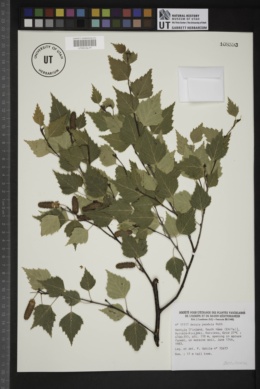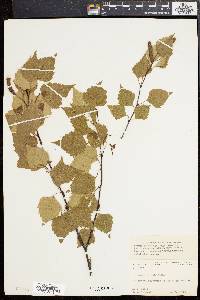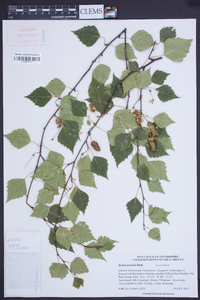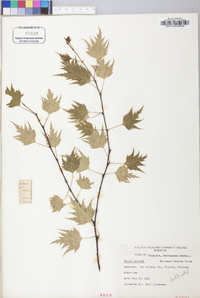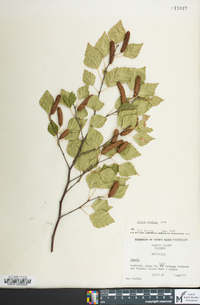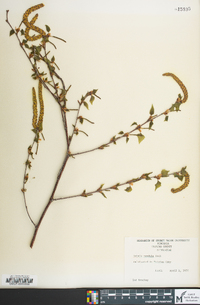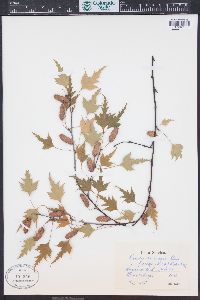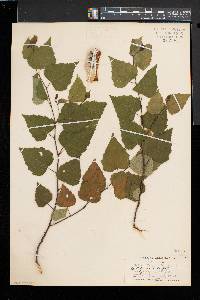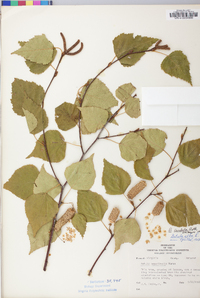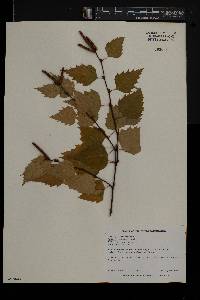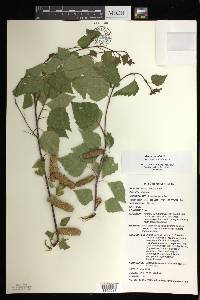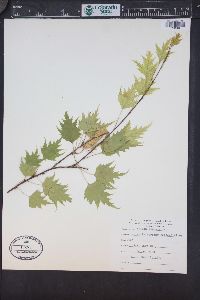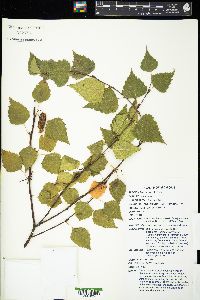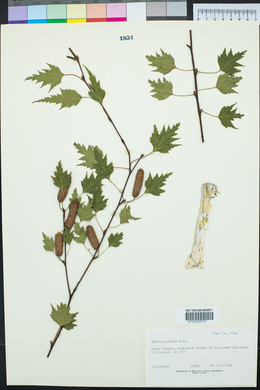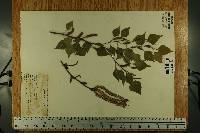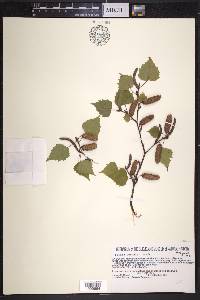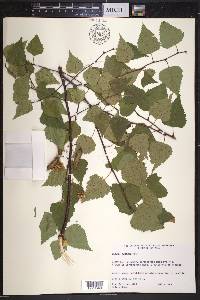Betula pendula
|
|
|
|
Family: Betulaceae
European Weeping Birch, more...European white birch, weeping birch, silver birch
|
Trees , to 25 m; trunks usually several, crowns spreading. Bark of mature trunks and branches creamy to silvery white, smooth, exfoliating as long strands; lenticels dark, horizontally expanded. Branches pendulous; twigs glabrous, usually dotted with small resinous glands. Leaf blade broadly ovate to rhombic with 5--18 pairs of lateral veins, 3--7 × 2.5--5 cm, base cuneate, rarely truncate, margins coarsely and sharply doubly serrate, apex acuminate; surfaces abaxially glabrous to sparsely pubescent, covered with minute, resinous glands. Infructescences erect to nearly pendulous, cylindric, 2--3.5 × 0.6--1 cm, shattering with fruits in fall; scales adaxially sparsely pubescent, lobes diverging at middle, central lobe obtuse, much shorter than lateral lobes, lateral lobes broad, rounded, extended. Samaras with wings much broader than body, broadest near center, extended beyond body apically. 2 n = 28, 56. Flowering late spring. Abandoned plantings, roadsides, edges of bogs, waste places; 0--350 m; B.C., Man., Ont.; Conn., Mass., N.H., N.Y., Ohio, Pa., Vt., Wash.; Europe; Asia. The Eurasian weeping birch ( Betula pendula ) is extensively cultivated throughout the temperate range of the flora, and it has been known to persist or to become locally naturalized in several areas, particularly in the Northeast. In vegetative features it resembles B . populifolia Marshall, to which it is closely allied; it can easily be distinguished from the latter by its peeling bark, as well as by its mostly pubescent leaves with somewhat shorter, acuminate apices.
Tree 8 - 25 m tall, trunk 10 - 25 cm in diameter Leaves: alternate, stalked, dark green above, paler with tiny resin glands beneath, 3 - 7 cm long, 2.5 - 6 cm wide, egg-shaped or triangular to four-sided with a squared to wedge-shaped base and a pointed tip, toothed, with five to eighteen pairs of veins. Leaves turn yellow in fall and hold onto trees longer than native birch leaves. Flowers: either male or female, found on the same tree (monoecious), borne in catkins. Male catkins are purplish brown, 2 - 3 cm long, and hang in groups of two to four at the ends of twigs. Female catkins pale green, 1 - 1.5 cm long, upright. Fruit: is a seed surrounded by two wings (samara), borne on a 2 - 4 cm long, 0.6 - 1 cm wide catkin that falls apart when ripe. The wings are wider than the seed, and the scales are cross-shaped with side lobes wider than top and bottom lobes. Bark: shiny reddish brown when young, changing to pinkish white with few dark gray scales and pale gray horizontal corky lines (lenticels), finally becoming creamy to silvery white with black diamond-shaped branch scars, thin, peeling in long narrow strips when it exfoliates (rarely), dark and furrowed at the base. Twigs: slender, reddish to purplish brown, covered with rough, raised resin glands. Terminal buds: absent. Form: conical and upright when young, developing graceful arching branches and becoming oval with age, often multi-trunked. End and lateral buds: purplish brown to brown, 3 - 4 mm long, egg-shaped to conical, curved. Similar species: Three white-barked birches grow in the Chicago Region: Betula papyrifera, Betula pendula, and Betula populifolia. Betula papyrifera has bark that peels in thin layers, leaves that are egg-shaped, and male catkins that are borne in groups of two or three. Betula populifolia has bark that does not exfoliate and develops black triangles below the branches, leaves that are widest at the base with a long-pointed tip, and male catkins that are usually borne singly. Flowering: April Habitat and ecology: Low sandy woods, bogs, and dunes. Introduced from Europe, B. pendula plants growing in the Chicago Region appear to be volunteer specimens from seeds of cultivated plantings. Occurence in the Chicago region: non-native Notes: This is a fast-growing, short-lived tree. Cut-leaved, weeping and purple-leaved forms have been developed for landscape use. Etymology: Betula is the Latin name for birch. Pendula comes from the Latin word meaning hanging. Author: The Morton Arboretum Occasionally escapes from cult. and would key to B. populifolia. It has drooping twigs; middle-sized trunks are beset with vertical, diamond-shaped, rough black marks that eventually coalesce. Gleason, Henry A. & Cronquist, Arthur J. 1991. Manual of vascular plants of northeastern United States and adjacent Canada. lxxv + 910 pp. ©The New York Botanical Garden. All rights reserved. Used by permission. From Flora of Indiana (1940) by Charles C. Deam Indiana Coefficient of Conservatism: C = null, non-native Wetland Indicator Status: FACU |
|
|
|

